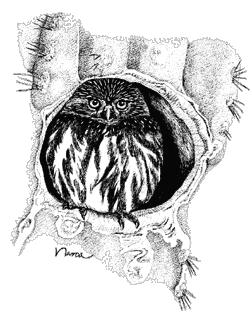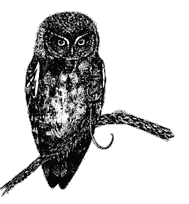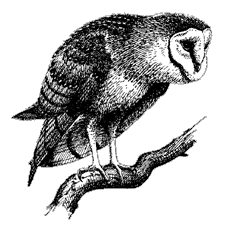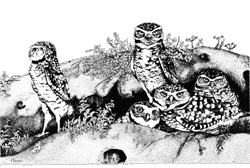Owls
The Sonoran Desert at night is a very lively place. Especially in summer, there are probably more creatures abroad at midnight than at noon. Of course, most birds shun this night shift, but several species of owl are notable exceptions.
Owls are superbly equipped to hunt at night. They cannot see in total darkness - no animal can do that - but their eyes are adapted for vision under very low light conditions. Even more impressive is their sense of hearing. Studies have shown that Barn Owls can locate their prey by sound alone, in total darkness, with pinpoint accuracy. Many of the creatures that they hunt also have excellent hearing, but the owls can approach them in silence; the sound of their wing beats is muffled by the softened edges of the larger wing feathers.
Great Horned Owls are found throughout the Americas and Barn Owls practically throughout the world, so it is no surprise that they can adapt to desert life. Great Horned Owls eat almost anything smaller than themselves from rabbits and skunks to snakes and insects. Barn Owls specialize on rodents and the smaller desert owls also tend to take small prey. The Ferruginous Pygmy-Owl, a tropical species that reaches its northern limit here, may hunt most at dawn and dusk, often catching songbirds. The world's smallest owl, the Elf Owl, nests in holes in saguaro cacti and ventures out at night to eat beetles and moths. Nocturnal insects are scarce in cold weather, so most Elf Owls retreat south into Mexico for the winter; other desert owls are present year-round.
--Kenn Kaufman
Sonoran Desert species:
Barn Owl (Tyto alba)
Western Screech-Owl (Otus kennicottii)
Great Horned Owl (Bubo virginianus)
Ferruginous Pygmy-Owl
(Glaucidium brasilianum)
Elf Owl (Micrathene whitneyi)
Burrowing Owl (Athene cunicularia)
 |
Order: Strigiformes
Family: Strigidae (all but Barn Owl)
Family: Tytonidae (Barn Owl)
Spanish names: lechuza mono, lechuza común (Barn Owl), tecolotito chillon
(Western Screech-Owl), tecolote cornudo, buho (Great Horned Owl), tecolote
enano (Elf Owl), lechuza llanera, lechuza de ojo (Burrowing Owl)
Distinguishing Features
Barn Owl: This is a long-legged, knock-kneed, pale, monkey-faced owl. It has no ear tufts, and the pale face resembles a heart-shaped disc. The back is golden-brown, the belly is white. The voice is a loud, rasping screech. Western Screech-Owl: A common bird in our area, it is small, measuring only about 8 inches (20 cm). It is gray, streaked with black and white, has conspicuous “ear” tufts and is zygodactylous (2 toes point forward, 2 backward). Its call, a trill of several notes that become more rapid (like a bouncing ball), distinguishes it from the similar Whiskered Screech-Owl, which lives in oak woodlands. Great Horned Owl: Measuring almost 2 feet (61 cm) tall, this is our largest owl. It has a white throat, barred underside, and prominent ear tufts. Ferruginous Pygmy-Owl: This small (6¼ to 7 inch; 17 cm), uncommon, “earless” owl is reddish-brown with a faintly cross-barred tail. The crown has many white streaks and the underside is white with red-brown streaks.
 |
Elf Owl: About the size of a sparrow (5 inches tall; 13 cm), this is one of the smallest owls in the world. It has no ear tufts, and is grayish-brown with a white brow. The call consists of a variety of soft yelping notes, often running together into a high-pitched chatter. Burrowing Owl: About the size of a screech-owl, it is brown, spotted with tan, and lacks ear tufts; the long legs are almost featherless.
Click to hear Screech Owl sounds
Click to hear more Screech Owl sounds
Habitat
Barn Owl: This owl occurs throughout our area and through much of the U.S., Europe, Asia, and Africa. It is widespread but local. It is often found in conjunction with human habitation, roosting and nesting in barns, under bridges, in mine shafts, and in palm trees. It often nests in the undercuts of arroyos.
 |
Western Screech-Owl: The screech-owl occurs from southwestern Canada into Mexico. It is a resident of wooded areas from low desert into the mountains.
Great Horned Owl: This owl occurs throughout the New World, except the extreme north. It is found in every habitat within our region.
Ferruginous Pygmy-Owl: This species ranges from southern Arizona and southernTexas, south through Central and South America. The Ferruginous Pygmy-Owl is found in saguaro deserts and wooded river bottoms. In the tropics it inhabits a wide variety of wooded or semi-open habitats.
Elf Owl: The Elf Owl occurs from western Mexico through the southwestern United States. In our region, it may be found mostly in riparian habitats or in association with the saguaro.
Burrowing Owl: This species occurs from southwestern Canada to Tierra del Fuego, at the tip of South America. It prefers open country, prairie and desert. It is frequently seen in desert and grassland regions, standing on mounds or fence posts during the day.
Feeding
• Diet: The Barn Owl feeds on large numbers of rats and mice. Western Screech-Owl feeds on invertebrates and vertebrates. The Great Horned Owl has an extremely varied diet that includes birds, skunks, snakes, lizards, insects, and even frogs and fish. Lagomorphs (rabbits and hares) and rodents make up the bulk of the diet. The Ferruginous Pygmy-Owl prefers lizards and large insects, but will also take scorpions and small birds and mammals. The Elf Owl feeds primarily on invertebrates such as scorpions, centipedes, beetles and moths. The Burrowing Owl feeds on insects, rodents and small reptiles.
• Behavior: Barn Owl: An expert nocturnal predator, it finds its prey at night with exceptionally acute hearing and vision. The owl, like most birds of prey, ingests bone and fur when it eats its prey. However, the digestive processes of the owl are not capable of digesting bone and fur. This residual material is formed into a pellet in the stomach and regurgitated. Food habit studies of owls are easily done by examining the contents of the pellets found in or near their roosts. Western Screech-Owl: The streaked pattern of the owl blends well with desert shrubs while hunting. Highly nocturnal. Great Horned Owl: A nocturnal predator with extremely acute sound perception and night vision. The soft feathers are an adaptation to its hunting style of obtaining food. These feathers do not make any sound in flight; therefore, the bird can hear the prey and locate its position, but the prey cannot hear the owl. This owl is an extremely important predator of jackrabbits and cottontails. Ferruginous Pygmy-Owl: This pugnacious owl is most active at night, but it is also active during the day, especially at dawn and late afternoon.
Life History
Barn Owl nesting activity peaks in the spring, with 5 to 6 white eggs laid in a depression in a tree cavity, cave, mine shaft, or building. The female incubates the eggs about 33 days. The young remain in the nest for 7 to 8 weeks. The barn owl characteristically begins incubating the first egg, and while incubating it, lays additional eggs. Since the eggs are laid 1 to 2 days apart, the young hatch 1 to 2 days apart. Therefore, chicks of various ages (development stages) can be found in one nest. Often the older siblings starve out the younger. Once one dies, it is fed to the older nestlings. The young are very noisy, crying raucously when the adults feed them.
The Western Screech-Owl nests in tree cavities; in our area it commonly nests in saguaro holes. The eggs are white with 4 to 5 in a clutch. They are incubated for about 26 days. The male feeds the female during incubation.
The Great Horned Owl begins nesting during January or February, usually in an abandoned hawk nest or on a ledge. The white eggs are usually laid 2 or 3 to a clutch. The owls actively defend the nest territory.
The Ferruginous Pygmy-Owl female lays 3 or 4 white eggs in hollows of saguaros or other trees. The nest, which contains no nesting materials, may be used for many years. The incubation period is about 28 days; the male feeds the sitting female and both parents feed nestlings. The young are able to fly 27 to 30 days after hatching.
 |
The Elf Owl uses old woodpecker nest cavities for its nests. The white eggs are usually laid 3 to 4 to a clutch. Starlings, which are an introduced bird from Europe, pose a threat to Elf Owls. They take over nest cavities already in use by the Elf Owls, or by other birds.
The Burrowing Owl nests in the used burrows of other animals, most commonly ground squirrels and prairie dogs. The white eggs number from 5 to 10, and are laid in underground nests. The babies spend most of their early life underground, but emerge before they are fully fledged to exercise their flight muscles. When disturbed in a burrow, the owl mimics a rattlesnake’s rattle. The adults are probably preyed upon by other predators; the chicks are taken by snakes.










